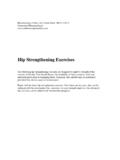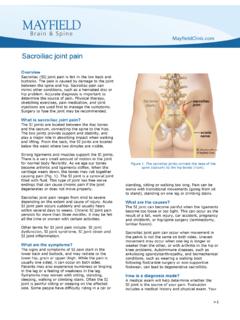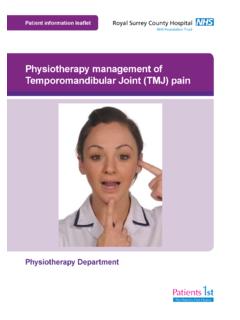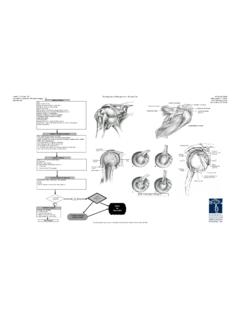Transcription of TITLE:THE ROLE OF RHEUMATOID FACTOR IN THE …
1 1 title : THE ROLE OF RHEUMATOID FACTOR IN THE DIAGNOSIS OF RHEUMATOID arthritis By Prof. Fahim Khan/MD,MRCP,FRCP,FACP Index: 1. Abstract RHEUMATOID factors Anti-CCP Antibodies Combination of RHEUMATOID FACTOR and Anti-CCP Antibodies Findings 2. Methodology 3. Background The prevalence of RHEUMATOID FACTOR 4. Findings To Date Pathophysiology Clinical disorders associated with RF positivity 2 RF titer Predictive value Prognostic value Anti-cyclic citrullinated peptide (CCP) antibodies 5. Future Future Reccommendations 6.
2 Conclusion Summary and Recommendations 7. References 1. Abstract: RHEUMATOID factors : RHEUMATOID factors (RF) are autoantibodies directed against the Fc portion of IgG. RHEUMATOID FACTOR is a well-established diagnostic and prognostic test in RHEUMATOID arthritis . High titer IgM RF is relatively specific for the diagnosis of RA in the context of a chronic polyarthritis, and was for decades the sole serologic criterion widely used in the diagnosis of RA. Patients with RHEUMATOID arthritis (RA) follow a variable disease course with regard to outcome measures such as functional status or radiological assessment of joint damage.
3 Early identification of patients with RA and, in particular, those likely to assume a more rapidly destructive form of disease, is important because of the possible benefit from early, aggressive intervention with disease modifying agents. This realization has prompted the investigation and measurement of numerous biologic "markers" in blood and joint fluids that may serve as 3 indicators of prognosis and the response to therapy. Although some of the markers under consideration are accessible in routine practice, many are in the stage of experimental evaluation and require access to specialized technology and customized reagents.
4 RF also occurs in other diseases. As an example, some connective tissue diseases, such as systemic lupus erythematosus (SLE) and primary Sj gren's syndrome, may be associated with the presence of RF. In addition, RF levels may be elevated in patients with certain infections, such as malaria, rubella, hepatitis C, and following vaccinations. It has little predictive value in the general population; however, since the overall disease prevalence is relatively low. RHEUMATOID FACTOR may have some prognostic value with regard to disease manifestations and activity, and the severity of joint erosions.
5 Seropositive RA (ie, RA associated with a positive RHEUMATOID FACTOR test) is often associated with more aggressive joint disease, and is more commonly complicated by extra-articular manifestations than seronegative RA Anti-CCP Antibodies: Among the many biologic markers that have been assessed for usefulness in estimating disease, activity and prognosis of RHEUMATOID arthritis , only a few have found a role in clinical practice. At present the main clinically useful biologic markers in patients with RA are RHEUMATOID factors and antibodies to citrullinated peptides, for both diagnosis and prediction of functional and radiographic outcomes, as well as erythrocyte sedimentation rate (ESR) and C-reactive protein (CRP) for AA functional and radiographic outcomes.
6 Anti-CCP testing is a clinically useful tool in diagnosis or exclusion of RA in patients with polyarthritis. Patients with an established diagnosis of RA who have a positive test for RF, anti-CCP antibodies, or both are at a higher risk of developing erosive joint damage and functional impairment. As a result, such patients should receive anti-rheumatic therapy that suppresses disease activity early in the course of their 4 disease. Diagnoses other than RA should be considered in patients who are both RF and anti-CCP antibody negative. Unless it is demonstrated that there is an intervention that effectively and safely reduces the risk of developing RA, there is no role for screening asymptomatic individuals for either RF or anti-CCP antibodies.
7 Presently, the main clinically useful biologic markers in patients with RA are RHEUMATOID factors and antibodies to citrullinated peptides Anti CCP Antibody test for both diagnosis and prediction of functional and radiographic outcomes. Combination of RHEUMATOID FACTOR and Anti-CCP Antibodies: Testing for the combination of anti-CCP antibodies and IgM RF may be better for excluding the diagnosis of RA than is achievable by testing for either antibody alone. Those with early arthritis who are RF or anti-CCP antibody positive are at an increased risk of developing RA and erosive joint disease, while those with neither of these markers are less likely to develop joint damage.
8 Thus, earlier intervention with disease modifying antirheumatic drug (DMARD) therapy may be warranted in those with positive markers, while symptomatic treatment ( with nonsteroidal anti-inflammatory drugs) may be appropriate for those lacking both RF and anti-CCP antibodies when first seen. Findings: Diagnoses other than RA should be considered in patients who are both RF and anti-CCP antibody negative. Unless it is demonstrated that there is an intervention that effectively and safely reduces the risk of developing RA, there is no role for screening asymptomatic individuals for either RF or anti-CCP antibodies.
9 5 2. METHODOLOGY: This dissertation is aimed to identify the role of RHEUMATOID FACTOR in the diagnosis of RHEUMATOID arthritis and the value of biologic markers that have been assessed for usefulness in estimating disease activity and prognosis of RHEUMATOID arthritis , particularly the use of anti-CCP antibodies test in diagnosing early RHEUMATOID arthritis . Access to numerous articles and case studies relevant to my dissertation was collected by using separate electronic databases and search engines which include: Pub Med, Medline, E Medicine, Medscape, Up-to-date and Athens/Oxford library search base.
10 The following journals were also consulted for the topic on RHEUMATOID FACTOR including: arthritis and Rheumatism , British Journal of Rheumatology , Up-to-Date Journal , Journal of Rheumatology , American Journal of Medicine , and the New England Journal of Medicine Several key words and terms helped to define the initial search and was used to gather different abstracts and articles to finalise the topic. The search terms employed were as follows: RHEUMATOID FACTOR Pathogenesis RHEUMATOID FACTOR Predictive and prognostic values of RHEUMATOID FACTOR RHEUMATOID FACTOR Titer Anti-CCP Antibodies After the initial search strategy yield with articles and research studies on RHEUMATOID arthritis , RHEUMATOID FACTOR and Anti CCP antibodies, over 1000 articles were narrowed by using RHEUMATOID FACTOR to get the relevant information on finalizing this dissertation.











